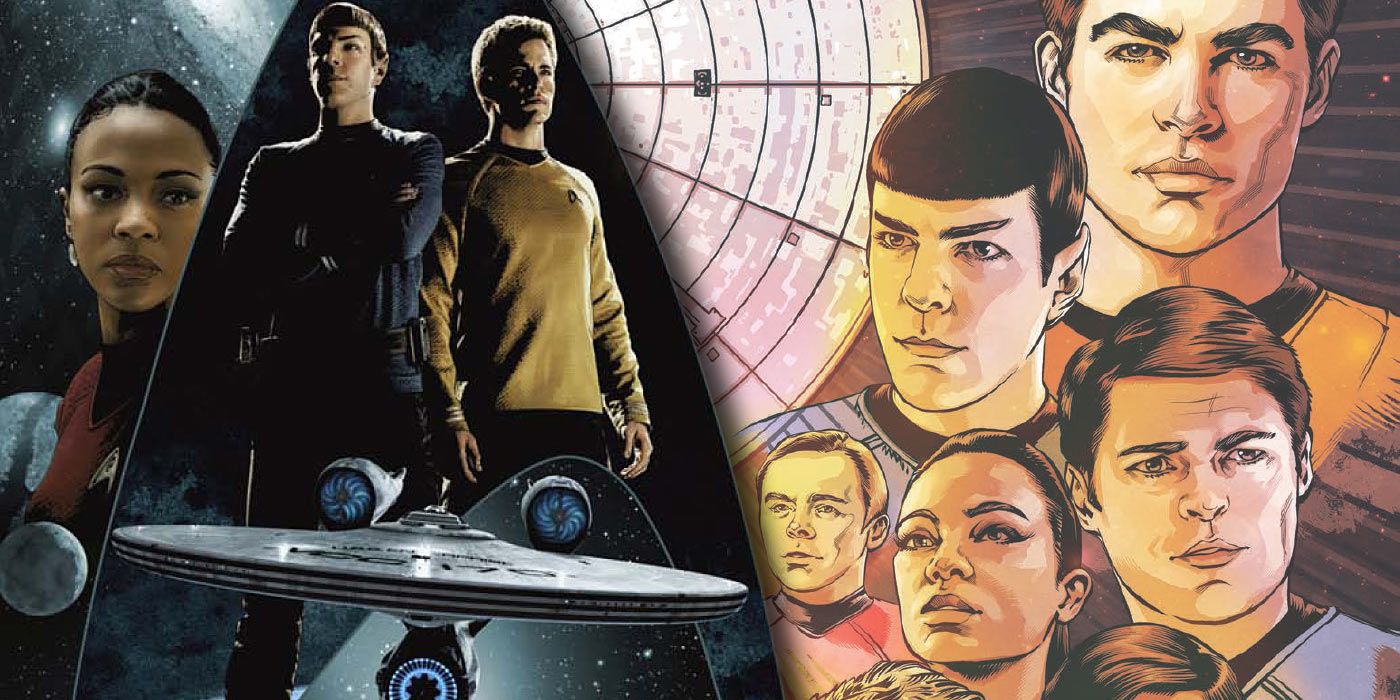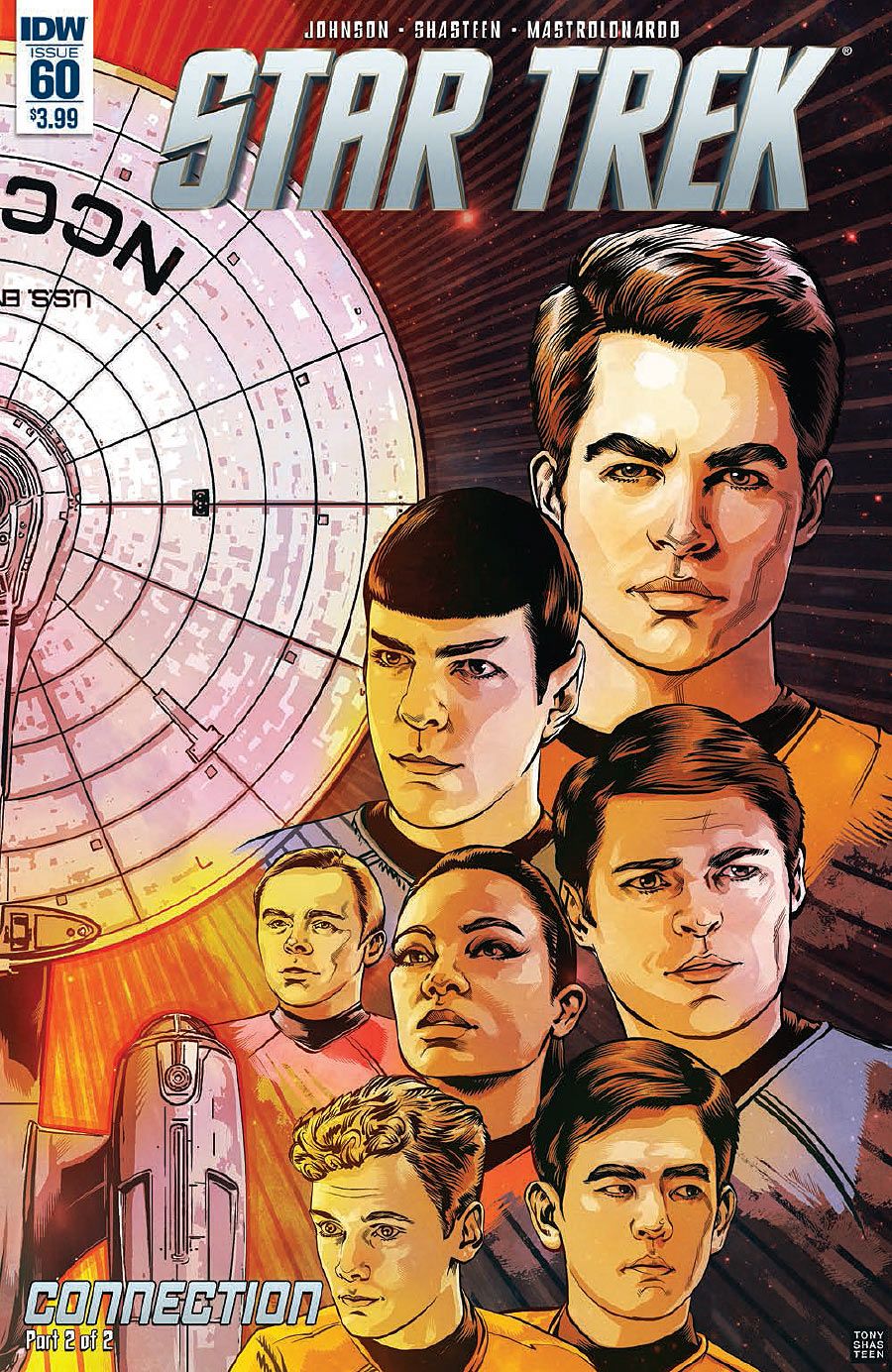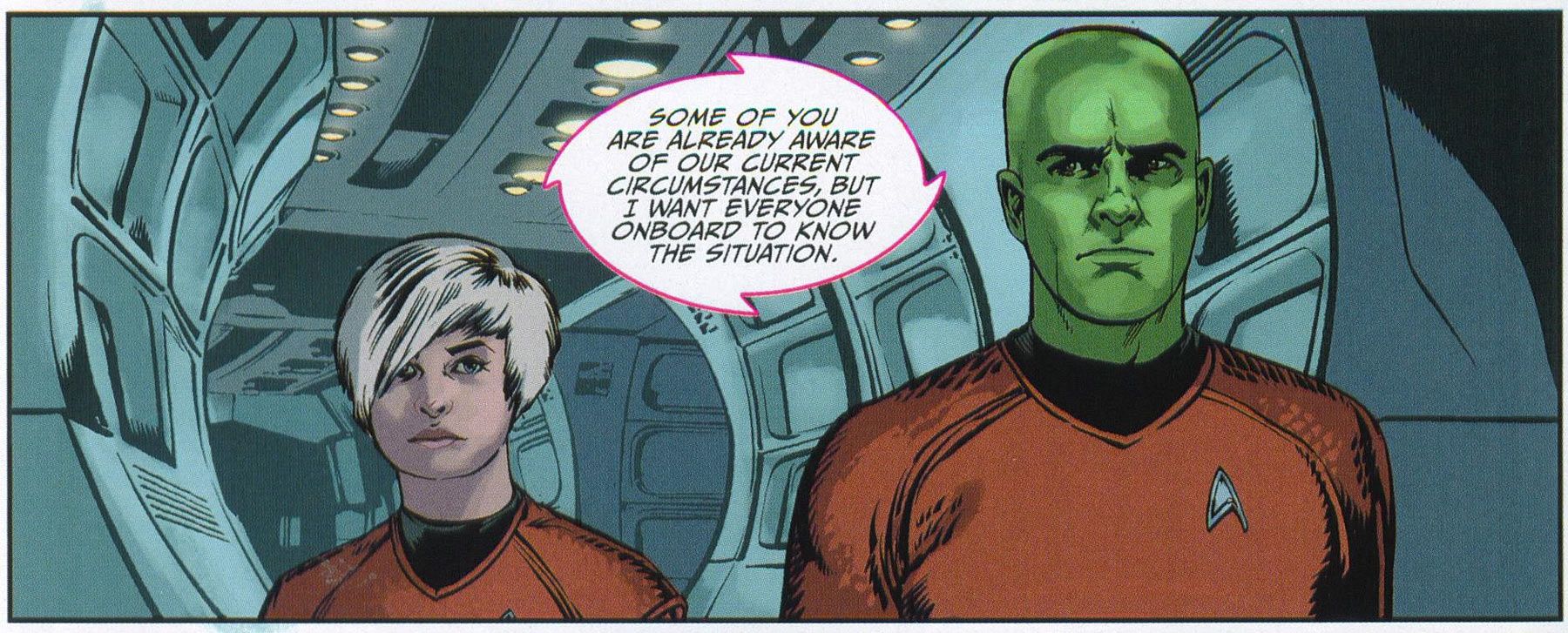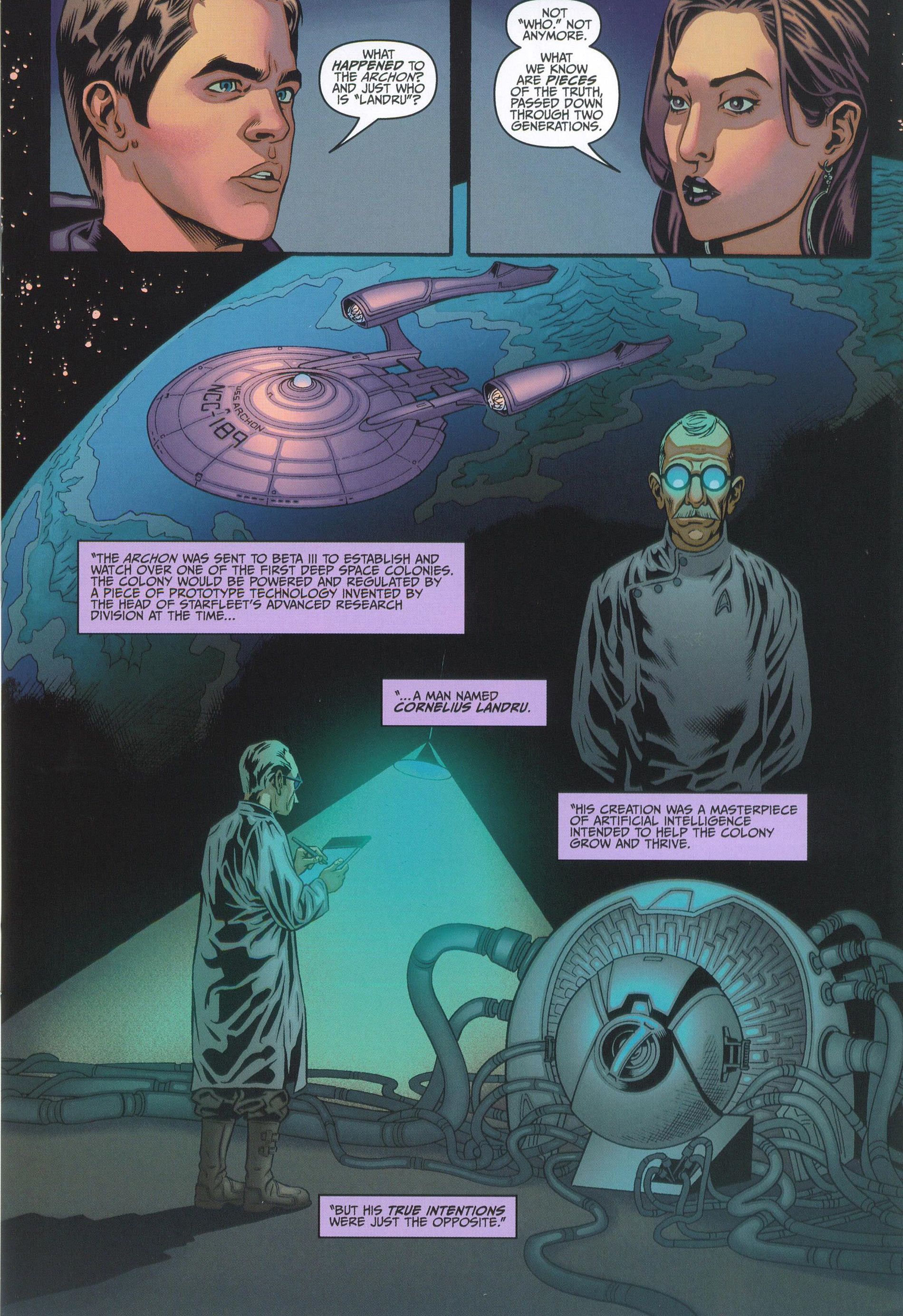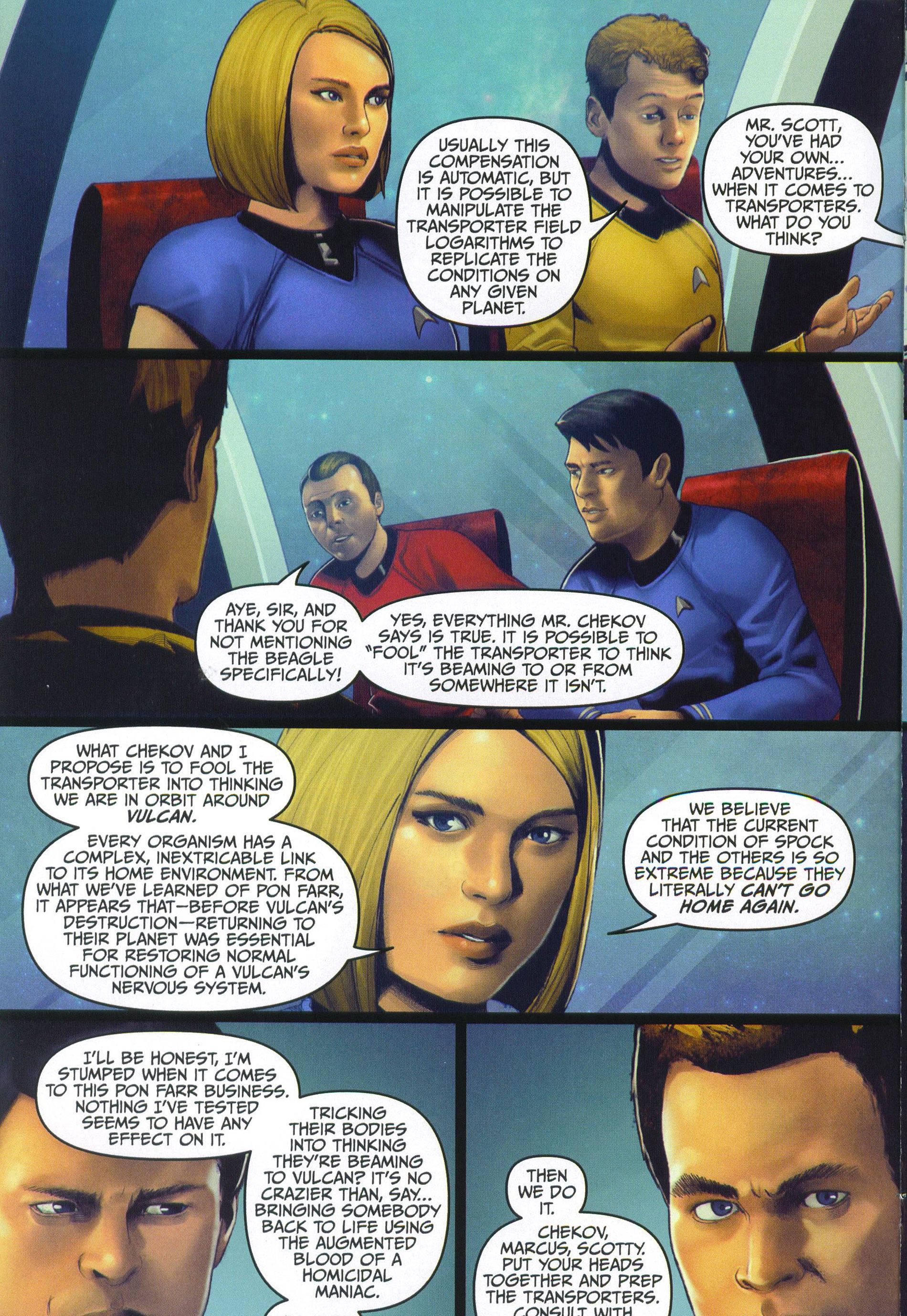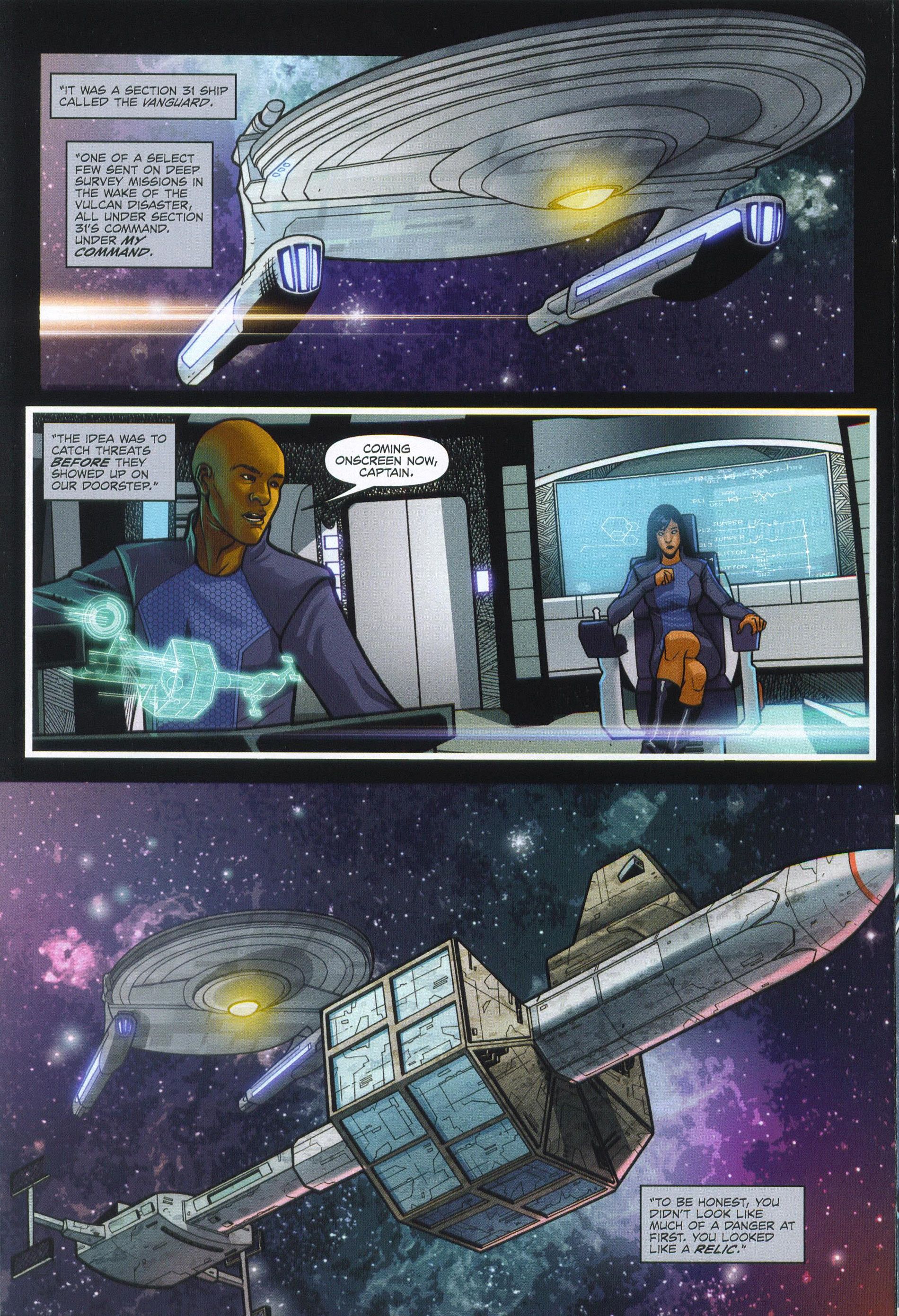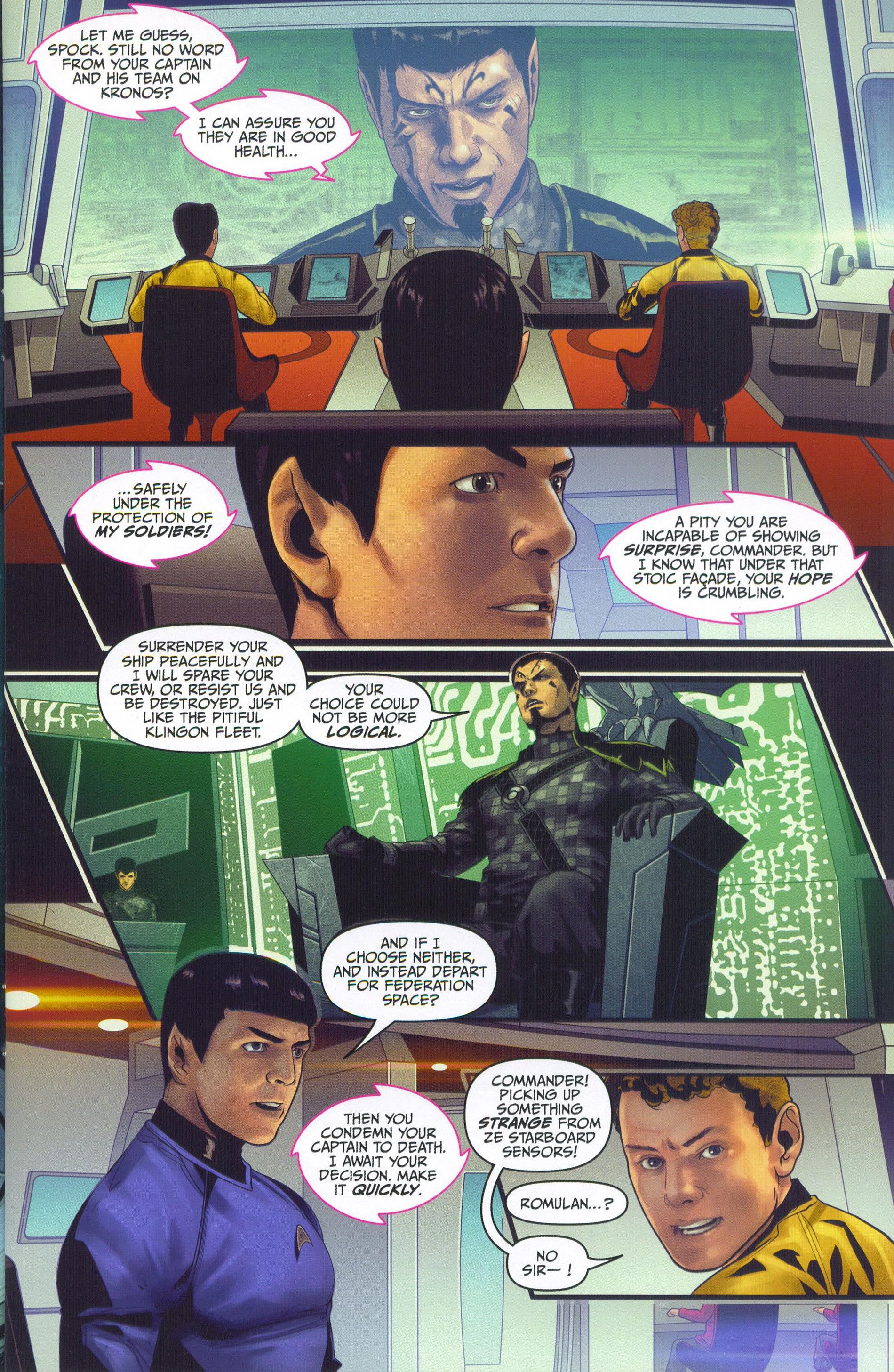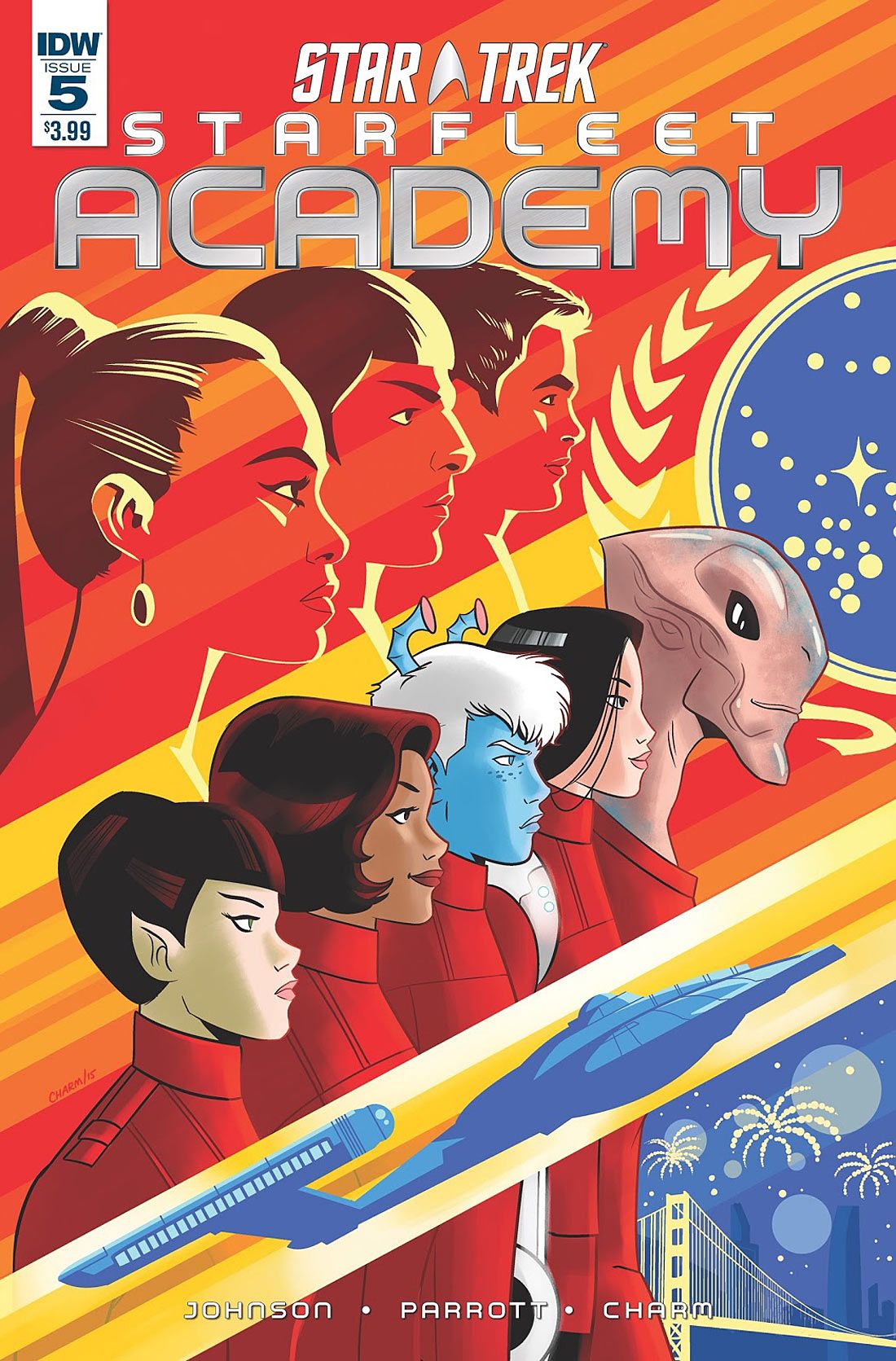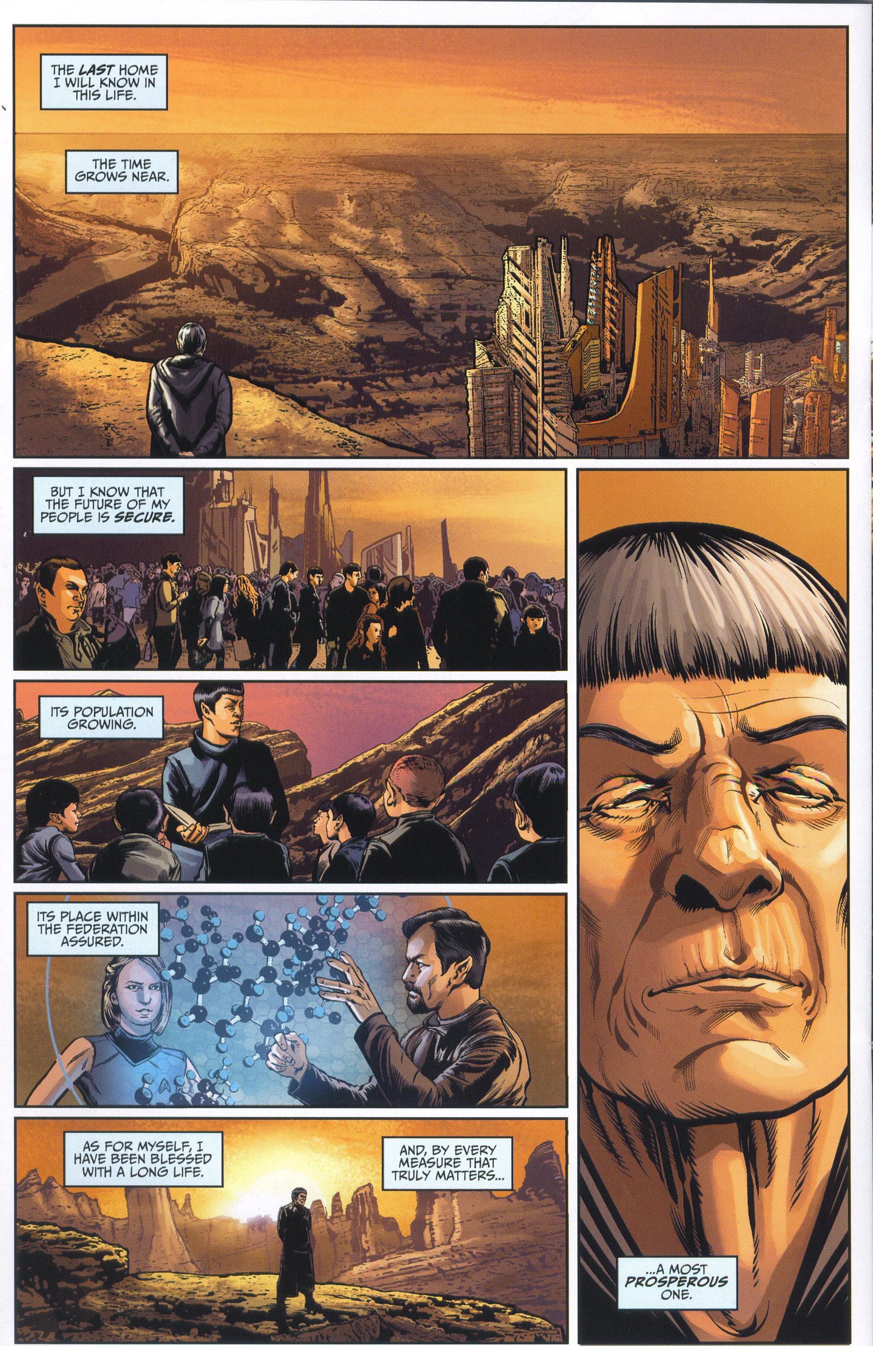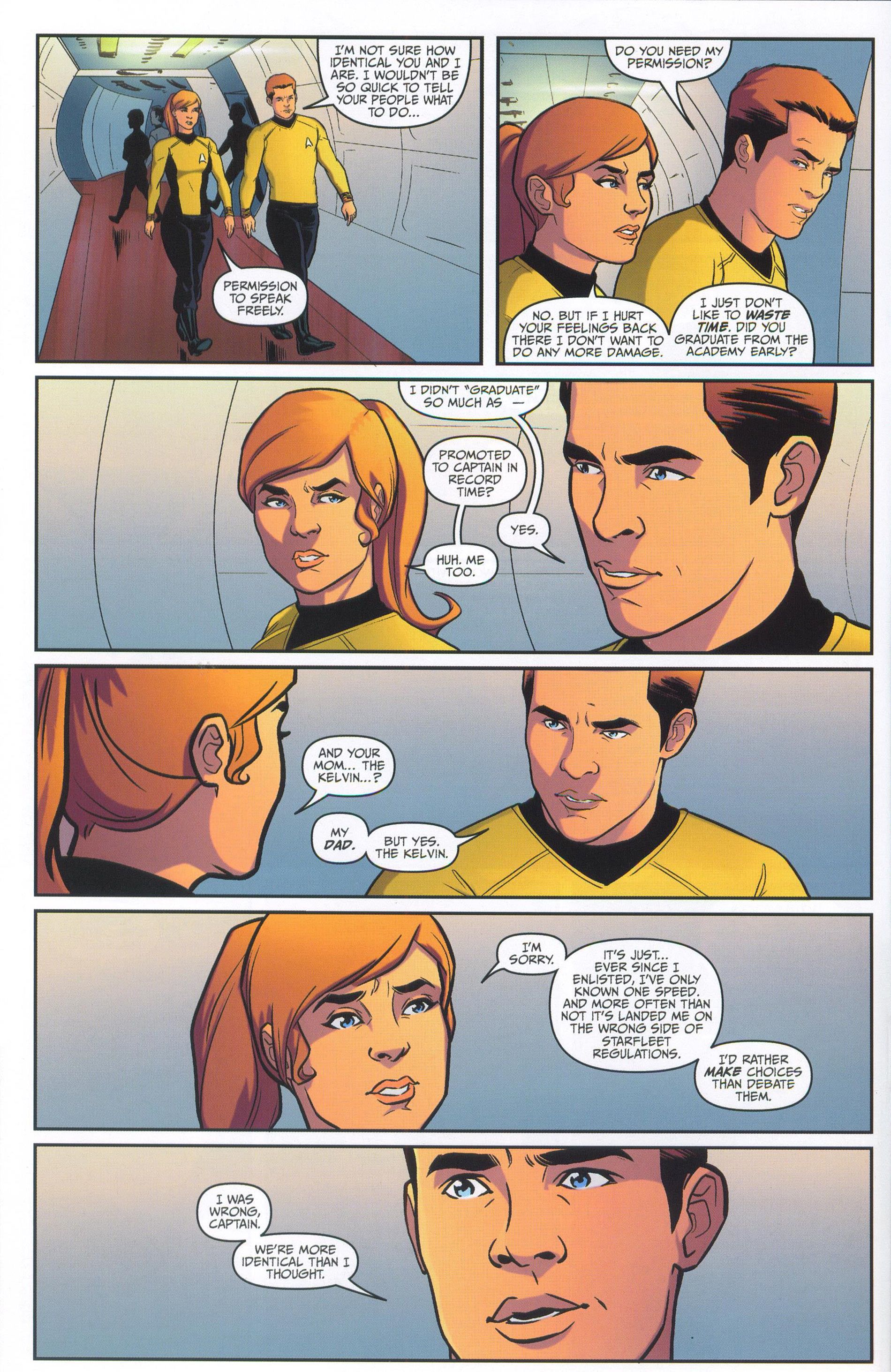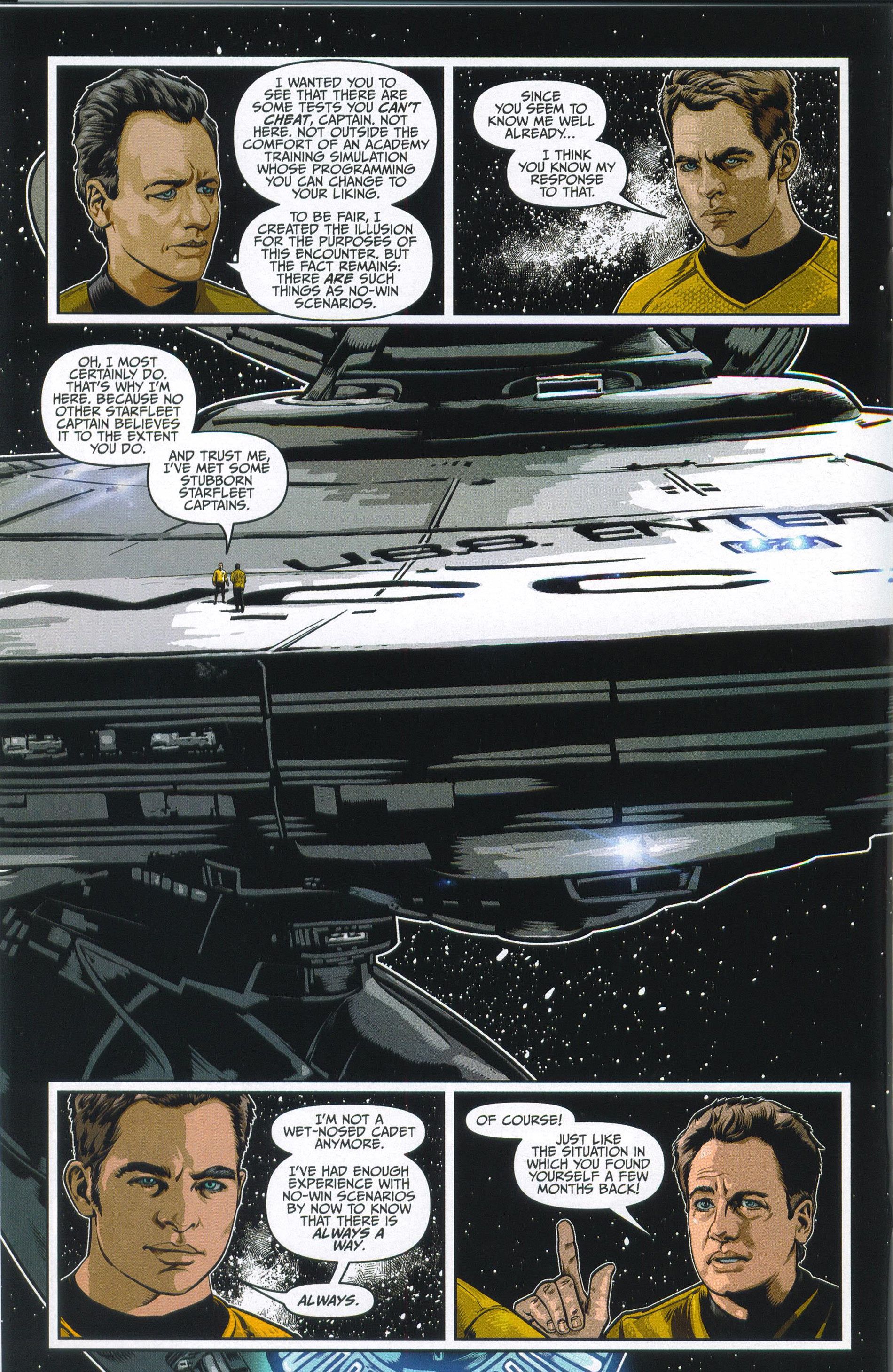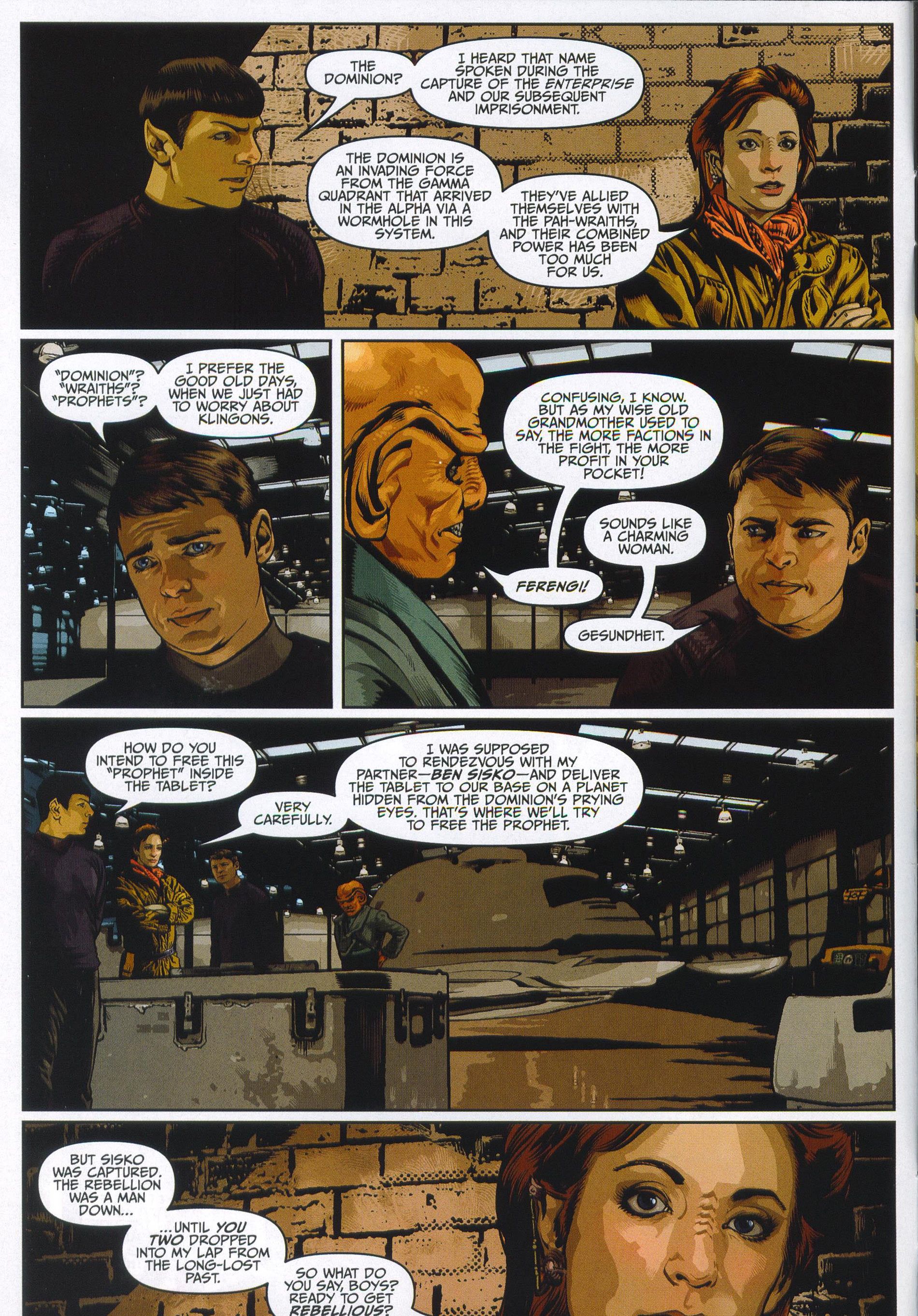IDW Publishing has been the comic book home of "Star Trek" for almost ten years, and for the past five years has put out a monthly "Trek" series (and a handful of affiliated miniseries) chronicling the voyages of the Kelvin Timeline's Enterprise. This September, IDW will debut "Star Trek: Boldly Go," a new series picking up after the events of this summer's "Star Trek Beyond." That means the current series is wrapping up, with its final issue (#60) arriving in comic shops today.
1 HONORABLE MENTIONS
Before the countdown starts in earnest, I couldn't pass up some of the series' more clever nods to its Prime Universe inspiration:
- In issues #1-2, Johnson and Molnar adapted the first Jim Kirk episode (and the series' second pilot episode) "Where No Man Has Gone Before." The original featured Sally Kellerman as Dr. Elizabeth Dehner, ship's psychologist; but because the cast wasn't yet final, also had Dr. Mark Piper (Paul Fix) as chief medical officer. IDW's adaptation replaced Piper with Doctor McCoy (naturally) and omitted Dehner, explaining that she refused a transfer to the Enterprise because of her history with Bones.
- Closing out the series' first year, "The Truth About Tribbles" (issues #11-12) revealed that when Scotty and Keenser left the Delta Vega outpost for the Enterprise, a hibernating tribble came along. Still trying to recover Admiral Archer's prize beagle, Scotty used the tribble in a long-range transporter experiment and ended up infesting both his ship and Starfleet Headquarters. Nevertheless, at the end of issue #12, he did recover the beagle.
-
Other clever twists on classic episodes included Uhura stealing a shuttlecraft to rescue "The Galileo Seven" (issues #3-4); the "Doomsday Machine" homage in "Behemoth" (issues #41-42); a delusional Sulu separating the saucer section in "The Tholian Webs" (issues #46-47); the Mirror Universe's Kirk hijacking the Narada in "Mirrored" (issues #15-16); and the Mirror Khan teaming up with our heroes in "Live/Evil" (issues #50-52).
10. "Star Trek/Green Lantern: The Spectrum War"
6-issue miniseries (July-December 2015) Written by Scott and David Tipton, drawn by Angel Hernandez and colored by Angelo Sanchez, this miniseries is essentially "Blackest Night" in the 23rd Century. Most of the bridge crew joins the emotional spectrum, there's a planet full of Black Lanterns, and some familiar fleets get color-coordinated upgrades. Blending the two works pretty well, although the plot is essentially a framework for action sequences. The focus is on Kirk, Hal Jordan and the bad guys (including a Gorn Red Lantern, a Romulan Orange Lantern and Yellow Lantern Chang in his Kelvin-timeline debut). The climax also threatens to be fan-service-y -- and in fact, the miniseries ends on a very peculiar note. Nevertheless, in a "Trek" context the various Lantern Corps are essentially another set of warring factions the Enterprise crew must work with; the script is very true to everyone's voices; and the art and colors keep things lively. A sequel is on the way. 9. "Return of the Archons""Star Trek" #9-10 (May-June 2012) Not only was this two-parter (by Mike Johnson and Stephen Molnar) updated to make it more grounded in Starfleet history, in hindsight it helped lay the foundation for "Star Trek Into Darkness," the second film taking place in the newly minted Kelvin timeline. (For that matter, its big reveal also has a couple of things in common with the still-in-theaters "Star Trek Beyond.") The classic episode helped establish the "Kirk confuses a civilization-controlling computer" trope, but IDW's comic book version avoids that by making the computer (spoilers!) a remnant of the Starship Archon's century-old mission for Section 31. We also learn that the shadowy group tried unsuccessfully to recruit Sulu -- a tidbit which will set up another reveal several issues later. 8. "After Darkness""Star Trek" #21-23 (May-July 2013) As the title suggests, these issues pick up after "Into Darkness," with the Enterprise embarking officially on its five-year mission and science officer Carol Marcus a regular part of the crew. However, I'm tempted to call these issues "Amok Kelvin-Timeline," because they show Spock having to deal with pon farr when he can no longer return to the planet Vulcan. In the classic episode, Spock's purported mate T'Pring manipulated him into fighting Kirk. Here, though, T'Pring is fairly supportive, since Spock descends fairly quickly into red-eyed, vocabulary-deficient savagery and joins a group of similarly-affected Vulcans out in the New Vulcan wilds. Eventually Chekov and Marcus save the day, using the transporter to fool Spock into thinking he's beaming down to the real Vulcan. Not quite as emotionally affecting as the old "marriage or challenge" fake-out; but remember -- in this timeline Spock had already seen Kirk die. 7. "Star Trek: Khan"5-issue miniseries (October 2013-February 2014) Speaking of "Into Darkness," this miniseries (written by Johnson and drawn by David Messina and Claudia Balboni) fills in some of its gaps and spackles over many of its plot holes as it provides the Kelvin-fied account of Khan's origin. The pre-movie miniseries "Countdown to Darkness" couldn't do much of that, for reasons which became obvious in hindsight (although it did give readers some background on Admiral Marcus and the smuggler named Mudd). Novelist Greg Cox treated the Eugenics Wars as a series of conspiracy-fueled political maneuvers which left the 1990s superficially unchanged -- because, of course, we never noticed genetic supermen taking over a quarter of the Earth before being shot into space like some common Hulk. However, "Khan's" version starts with nuking Moscow and Washington, D.C. and includes battles across the globe. As before, the supermen are forced to flee when the nations of the world finally overwhelm their strongholds; but this time a Section 31-controlled starship picks up Khan and company. Section 31 then erases Khan's memories and changes his appearance to something decidedly non-Indian. Regardless, on a mission to destroy the Klingon moon Praxxis, "John Harrison" remembers who he is and confronts Admiral Marcus before going into hiding. Oh, and he also invents that magic transwarp transporter. I don't know if it makes "Into Darkness" any better, but all in all, it's a story worthy of its antiheroic star. 6. "The Khitomer Conflict""Star Trek" #25-28 (September-December 2013) As you can see, IDW's series dealt with a lot of "Into Darkness" fallout, but this was perhaps the most direct sequel. In it, the remnants of Section 31 arm the Romulans with red matter and advanced technology so they can go after the Klingons -- who, similarly, have adapted the technology from the Narada to their own fleet. The Romulans attack the Klingons' Khitomer outpost, but the Klingons blame the Federation; and to top it all off, there's a Section 31 agent on the Enterprise. (Don't read "Khan" before this one or you'll guess who it is.) The whole thing expands into a giant space battle between Romulans and Klingons with the Enterprise in the middle. After Kirk convinces the Section 31 agents not to destroy Qo'Nos with red matter, they use a Section 31 boobytrap to destroy all the upgraded Romulan ships. The agents escape aboard their cloaked starship, and Kirk reaffirms his crew's commitment to Starfleet's ideals. 5. "Star Trek: Starfleet Academy"5-issue miniseries (December 2015-April 2016) Written by Johnson and Ryan Parrott and drawn by Derek Charm, this miniseries was a departure in both look and format, even as it recalled a good chunk of 2009's "Star Trek" film. It featured parallel storylines, one set in 2258 when most of the regular cast were at the Academy and one in 2261 with a new group of cadets. (The stories are distinct enough that it's easy to forget only three years separates them -- and, therefore, that the regulars are mostly recent graduates.) In 2258, Cadet Uhura risks expulsion after uncovering the uncomfortable truth about the revered Starship Slayton. Three years later, Cadet T'Laan wants to serve her people on New Vulcan but gets conscripted into a "Goblet of Fire"-style competition pitting Starfleet Academy against schools from other planets. Not surprisingly, T'Laan also runs across the Slayton mystery during the "field trip" portion of the tournament. "Starfleet Academy" is well-plotted and filled with some endearing new characters (including a hothead Andorian cadet and a cadet of an extremely literal new species). Charm's art is a lot more cartoony than "Trek" comics tend to be, but it works for a tale that feels somewhat YA-influenced. He also draws a very scary Admiral Marcus. You can probably see the ending coming, but it's still fun getting there. 4. "Legacy of Spock""Star Trek" #55-58 (March-June 2016) The series' farewell to Leonard Nimoy flashes back to the aftermath of "Star Trek" '09, showing how Spock-Prime helped the last Vulcans find a new homeworld. (Their first choice was the doomed planet Ceti Alpha V, which obviously didn't work out.) It's not the smoothest of transitions, because once the Vulcans learn where he comes from and why he's here, they immediately disown him; and when he goes to Romulus to contact its resistance movement, he's subsequently put on trial for espionage. Making things worse is a pair of Nero's crew who want to complete their captain's mission. There are Prime Universe flashbacks to the Original Series and "Star Trek: The Next Generation's" "Unification," the Enterprise makes a timely appearance, and everyone gets closure one way or another. A perfect epilogue caps a great tribute. 3. "Parallel Lives""Star Trek" #29-30 Captain Jane Tiberia Kirk and the crew of her Enterprise encounter a spatial anomaly weakening the boundaries between alternate universes. Gender-swapping the crew isn't exactly new -- it goes back at least as far as the fan-fiction short story "The Procrustean Petard" in 1978's "Star Trek: The New Voyages 2" -- but Johnson and artist Yasmin Liang combine it with concerns arising from Kirk's relative inexperience. The anomaly is similar to the "lightning storm" the Kelvin encountered, so an admiral wonders whether that would make Kirk reluctant to investigate it. When he asks specifically about her having an "emotional" reaction, she responds: You can lose the code words, Admiral. "Emotional." "Headstrong." Just come on out and say it. A young female captain makes the bigwigs back in San Francisco nervous. [...] If they're concerned about my ability to follow orders, they should have assigned me to a desk job where they could keep tabs up close. Otherwise, they're welcome to come out here and drag me back. Later, when Jane's crew meets Jim's, he wants to pause and reflect on their differences and what they can learn from them; while she just wants to solve the problem. This causes some friction between the Kirks, but after they compare notes on their respective backgrounds, she apologizes: "[E]ver since I enlisted, I've only known one speed. And more often than not, it's landed me on the wrong side of Starfleet regulations. I'd rather make choices than debate them." Jim also apologizes: "We're more identical than I thought." Some unexpected multiversal cameos (a trio of Klingon-fied crew members, Mirror-Shatner, and Geordi La Forge) top off an effective exploration both of gender issues and of Kirk's essential qualities. 2. "The Q Gambit""Star Trek" #35-40 (July-December 2014) Probably the series' magnum opus, this epic gave Johnson and artist Tony Shasteen the chance to dive headlong into a gleefully apocalyptic "Deep Space Nine" team-up. It begins and ends with Ambassador Picard as a guest of Captain Data aboard the Enterprise-E, eight years after the events of "Star Trek: Nemesis." Q pops in to tell Picard that his old friend Ambassador Spock is still alive in an alternate universe -- but that universe is in grave danger unless Q can set things straight. In practice, though, Q seems most concerned with convincing the Kelvin Timeline's Kirk that there is too such a thing as a no-win scenario, and in order to prove it Q transports the Enterprise to a certain 24th Century Cardassian space station. The Federation went way downhill after the Enterprise disappeared, with the Dominion conquering most of the Alpha Quadrant and the Klingons taking control of Earth. A very familiar group of freedom fighters (piloting a very familiar "tough little ship") has taken it upon themselves to save the galaxy, and they're glad for the help of the legendary Enterprise crew. Once again it comes down to the Prophets and the Pah-Wraiths, but this time the Prophets' side gets a little help from a couple of unexpected sources. 1. "Hendorff," or "The Redshirt's Tale""Star Trek" #13 (September 2012) "Star Trek" '09 establishes that young Jim Kirk bounced around Iowa getting into trouble, and indeed was getting into more trouble, when Captain Christopher Pike broke up a bar fight and recruited him into Starfleet. One of the main participants in that fight was a future Enterprise security officer named Hendorff, whom Kirk first knew as "Cupcake." In issue #13, Johnson and Molnar devoted an entire issue to "Cupcake," blending a classic series episode with a character who might well have been just another trivia question. That episode, "The Apple," begins in a very typical "Star Trek" way, with a landing party losing a security officer to the perils of an alien world. Indeed, "The Apple" kills off just about all the landing party's red shirts, starting with Hendorff himself. However, in the Kelvin Timeline, Hendorff shields Spock from a killer plant's blast of poison darts, eventually waking up in Sickbay where Spock thanks him for his service. (Hendorff and Kirk had cleared the air previously, with Hendorff telling the captain "we all know what you did [against Nero], and we respect you for it.") Not only does "The Redshirt's Tale" spare Hendorff, it points out that there were no casualties on that particular mission. Hendorff, Mallory, and two other redshirts -- presumably counterparts of "The Apple's" casualties Kaplan and Marple -- observe that if not for some lucky breaks, they might not have made it back. Because the story is told from Hendorff's point of view (as a letter he's writing to his parents), the similarities to the episode sneak up on the reader, making its ultimate revelations more powerful. "The Apple" was so unkind to security officers that Memory Alpha called it "the episode in which the redshirt phenomenon comes to the fore," and "The Redshirt's Tale" wants no part of that. "Star Trek's" television sequels each made sure their security personnel wouldn't be killed indiscriminately. While Tasha Yar was an unfortunate exception, she did last most of "TNG's" first season. After that, security chiefs Worf, Odo, Tuvok and Reed were each integral parts of their shows' ensembles. Still, in a sense that only hung a lantern on the Original Series' ill-fated redshirts, and reinforced the hierarchy of the Big Three, the Other Four and Everyone Else. Moreover, "Star Trek" '09 flirted perilously with making Kirk a sort of 23rd Century Harry Potter, something which "Into Darkness" sought to correct and which (among other things) "The Redshirt's Tale" addresses explicitly. Although Hendorff was pretty much a punchline (no pun intended) in "ST09," Johnson and Molnar use him very purposefully. Through him they dignify one of "Star Trek's" hoariest cliches, call out one of the movie's biggest plot holes, and repurpose a very middle-of-the-road episode. IDW's "Trek" was consistently enjoyable throughout its 60 issues, but "The Redshirt's Tale" represented it at its best. What were your favorite moment from the last five years of IDW's "Star Trek" comics?

